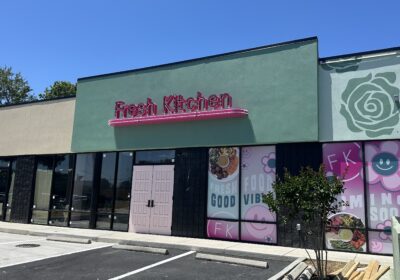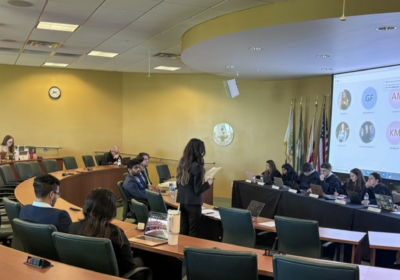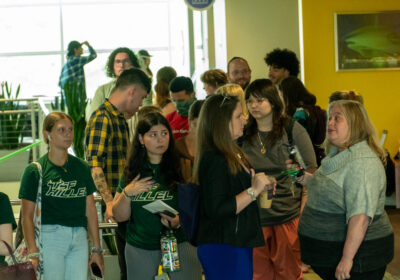An exhibition of the eclectic
Colorful, comic-inspired artwork, meticulous collections of objects and ongoing battles between fictional “Vegans” and “Mounds” are among the sights offered in a new Contemporary Art Museum (CAM) exhibition.
Houston artist Trenton Doyle Hancock’s exhibition “We Done All We Could and None of It’s Good” opened Friday and runs through March 10.
Though Hancock’s recent projects include a mural for the Dallas Cowboys’ stadium, this collection focuses on abstract collages and twisted illustrations.
In his multi-work-spanning narrative, Mounds are bulbous half-plant, half-humans that are continually murdered by the vengeful and skeletal Vegans. Other characters, such as the pink-caped superhero Torpedo Boy, occasionally appear in his artwork.
To the right of the gallery’s entrance hangs “Flower Bed II: A Prelude to Damnation,” a glow-in-the-dark wallpaper piece that stretches about 16-feet by 27-feet and displays a scene from the creatures’ conflict.
Within a repeating pattern of black-and-white text reading “we love you” and bright fluorescent shapes, the work depicts a cartoonishMound being stabbed in the eye by a sword-wielding disembodied arm.
David Norr, the exhibition’s chief curator, said during a public conversation with the artist Friday evening that Hancock’s open-ended mythology is what attracts many of his followers.
“It’s a story that’s ongoing, that changes, that swirls around and changes in ways unexpected even to the artist,” Norr said at the event.
A new drawing called “It Takes Two” shows Hancock appearing inside his narrative for the first time, according to the art’s description, as he stands behind Torpedo Boy in the dark Vegan underworld.
Rather than as a specific attack on vegans, Hancock said he created the two fictional species in college as an abstract way to deal with people’s self-righteous and damaging traits.
“I wanted to call out all the inhumane things I was seeing and all the tendencies humans have towards each other that are sometimes destructive,” Hancock said.
Yet, not all of his works delve into the world of Mounds and Vegans.
The sculpture “Color Coffin” restructures dresser drawers into a coffin filled with 14 sections of colored plastic covers, ranging from gloss paint can tops to Hagen-Dazs ice cream lids.
The drawers were originally part of a dresser that belonged to Hancock’s grandfather before his death. The work invokes ideas of mortality and the meaning in remnant objects, according to the event’s pamphlet.
Hancock said he gets inspiration from his habit of collecting objects over time – sometimes even reusing the materials in new artwork.
“I feel like I’m mining culture like an archaeologist to learn things about my surroundings,” Hancock said. “Some people would rather travel to Egypt or wherever to do their digs. My dig happens in thrift stores.”
His collage painting “You Are a Liar and the Truth is Not in You” displays two pink-and-black gravestones bearing the stark phrase.
Yet the canvas is also dotted with Gesso paint can lids, Odor Destroyer shoe insoles and old sketchbook pencil drawings.
Charles Sommer, a junior majoring in fine art, said he heard about Hancock through his classes and the series “Art21” on PBS and said he enjoyed how each piece used multiple artistic styles.
“I love the mixed media of it all – how everything’s not quite drawing, not quite painting,” Sommer said.
Mandi Porcelli, a sophomore majoring in art at the St. Petersburg campus, said she noticed how “mounds” of reused materials found their way into Hancock’s artwork.
“He has mounds of trash that he says have their own personalities,” Porcelli said. “I just learned about how he reflects that in his art.”
Hancock said his artwork is meant to bridge the gap between fine art galleries and supposedly low culture, like Garbage Pail Kids, into a “moat everyone can come across.”
“It’s pretty much eradicating this hierarchy – which I’ve never been a fan of – in what I take in visually,” Hancock said.
CAM hosts another colloquium with the artist Feb. 25 in FAH 101, where Hancock will discuss the narrative practices within his artwork.






